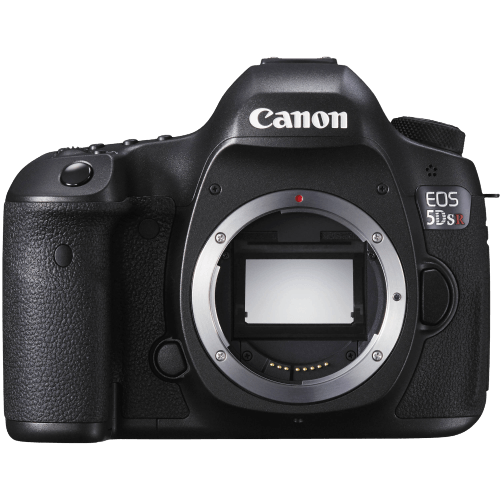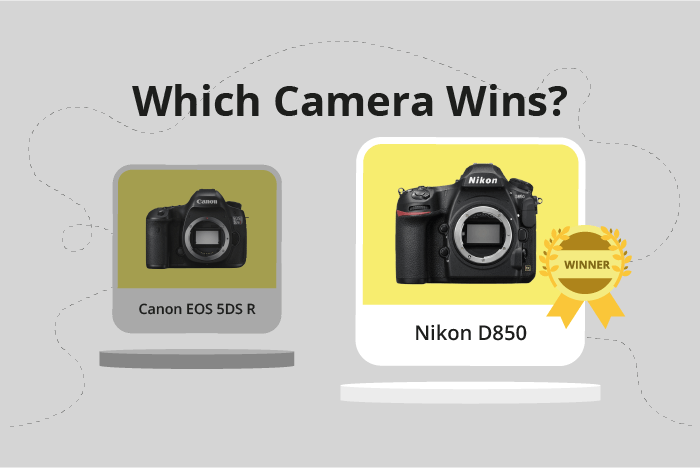Canon EOS 5DS R vs Nikon D850 Comparison
Canon EOS 5DS R

Nikon D850

The Nikon D850 emerges as the winner with a score of 82/100, while the Canon EOS 5DS R trails behind at 68/100. Both cameras are DSLRs and share similar dimensions, with the Nikon D850 measuring 146 x 124 x 79mm and the Canon EOS 5DS R at 152 x 116 x 76mm. The Nikon D850 is heavier, weighing 1005g compared to the Canon’s 930g.
The Nikon D850 boasts a lower launch price of $3300, compared to the Canon EOS 5DS R’s $3900. This price difference, along with the higher score, makes the Nikon D850 a more appealing option. However, the Canon EOS 5DS R has a slight advantage in terms of weight, making it easier to carry around.
Taking these factors into account, the Nikon D850 proves to be a better camera due to its higher score and more affordable price, while the Canon EOS 5DS R offers a lighter option for those prioritizing portability.
Canon EOS 5DS R vs Nikon D850 Overview and Optics
The Nikon D850 outperforms the Canon EOS 5DS R in optics, with a score of 79/100 compared to the Canon’s 73/100. Both cameras share several specifications, including a CMOS sensor, full-frame sensor size, and the absence of image stabilization. They also have different lens mounts, with the Canon using an EF mount and the Nikon using an F FX mount.
The higher score of the Nikon D850 is primarily due to its superior sensor and processor. The D850’s sensor has a DXOMARK score of 100, while the Canon 5DS R’s sensor scores an 86. The Nikon also boasts a more advanced processor, the Expeed 5, compared to the Canon’s Dual Digic 6. These factors contribute to the Nikon’s better image quality and overall performance.
The Canon EOS 5DS R has a higher megapixel count at 50.6, compared to the Nikon D850’s 45.7. However, this advantage is somewhat offset by the Nikon’s faster shooting speed of 7 frames per second (fps), as opposed to the Canon’s 5 fps. This makes the Nikon more suitable for capturing fast-moving subjects and action photography.
While the Canon 5DS R does have a higher megapixel count, the Nikon D850’s superior sensor and processor, along with its faster shooting speed, make it the more capable camera in terms of optics. The Canon’s only advantage in this comparison is its slightly higher resolution, which may not be significant enough to sway potential buyers in its favor. In comparing the optics of these two cameras, the Nikon D850 emerges as the clear winner.
Canon EOS 5DS R vs Nikon D850 Video Performance
The Nikon D850 outperforms the Canon EOS 5DS R in video capabilities, scoring 70 out of 100 compared to the Canon’s 57. Both cameras share some common video specifications, such as a maximum video frame rate of 30fps and built-in time-lapse functionality. However, the Nikon D850 surpasses the Canon EOS 5DS R in other areas, making it the superior choice for video recording.
The most significant advantage of the Nikon D850 is its 4K video resolution, with maximum video dimensions of 3840 x 2160. This higher resolution provides more detail and clarity in the recorded video, making it ideal for professional videography and high-quality content creation. On the other hand, the Canon EOS 5DS R only offers Full HD video resolution with maximum video dimensions of 1920 x 1080, which is not as impressive as the Nikon’s 4K capability.
Despite its lower video score, the Canon EOS 5DS R still has some strong video features, such as its built-in time-lapse functionality. This feature is also present in the Nikon D850, allowing both cameras to create stunning time-lapse videos without the need for additional software or equipment.
In terms of video capabilities, the Nikon D850 is the clear winner due to its 4K video resolution and higher video score. While the Canon EOS 5DS R has some good video features, it falls short in comparison to the Nikon D850’s superior video quality. For users seeking a camera with exceptional video performance, the Nikon D850 is the better choice.
Canon EOS 5DS R vs Nikon D850 Features and Benefits
The Nikon D850 outperforms the Canon EOS 5DS R in features, scoring 87/100 compared to the Canon’s 59/100. Both cameras share certain specifications, such as a 3.2-inch screen size and the absence of a flip screen and GPS. However, the Nikon D850 surpasses the Canon EOS 5DS R in several aspects.
The Nikon D850 has a higher screen resolution of 2,359,000 dots, while the Canon EOS 5DS R has only 1,040,000 dots. This difference results in a sharper and clearer display on the Nikon D850. Additionally, the Nikon D850 has a touchscreen, making it more user-friendly and easier to navigate compared to the Canon EOS 5DS R, which lacks this feature.
Connectivity is another area where the Nikon D850 outshines the Canon EOS 5DS R. The Nikon D850 comes with Wi-Fi and Bluetooth capabilities, allowing for seamless file transfer and remote camera control. On the other hand, the Canon EOS 5DS R does not offer either of these features, making it less convenient for modern photographers who value wireless connectivity.
Despite these disparities, the Canon EOS 5DS R does not have any significant advantages over the Nikon D850 in terms of features. The Nikon D850’s superior screen resolution, touchscreen, and connectivity options make it the clear winner in this comparison.
Taking all factors into account, the Nikon D850 is the better camera in terms of features. Its higher score reflects its advanced specifications and user-friendly design, making it a more appealing choice for photographers seeking a versatile and technologically advanced camera.
Canon EOS 5DS R vs Nikon D850 Storage and Battery
The Nikon D850 triumphs over the Canon EOS 5DS R in storage and battery with a score of 84/100 compared to the Canon’s 65/100. Both cameras have two memory card slots, but the Nikon D850 accepts SD/SDHC/SDXC (UHS-II compatible) and XQD cards, while the Canon EOS 5DS R is compatible with SD/SDHC/SDXC (UHS-I compatible) and Compact Flash cards.
The Nikon D850’s battery life outperforms the Canon EOS 5DS R, providing 1840 shots with its EN-EL15a battery, while the Canon’s LP-E6 battery allows for 700 shots. Neither camera has USB charging.
Though the Canon EOS 5DS R falls short in battery life and memory card compatibility, it still offers versatility in storage options with its dual card slots.
Considering these factors, the Nikon D850 emerges as the superior choice for storage and battery performance, granting users longer shooting time and more advanced memory card compatibility. The Canon EOS 5DS R, while not as strong in this category, still provides adequate storage options for photographers.
Alternatives to the Canon EOS 5DS R and Nikon D850
Are you still undecided about which camera is right for you? Have a look at these popular comparisons that feature the Canon EOS 5DS R or the Nikon D850:

